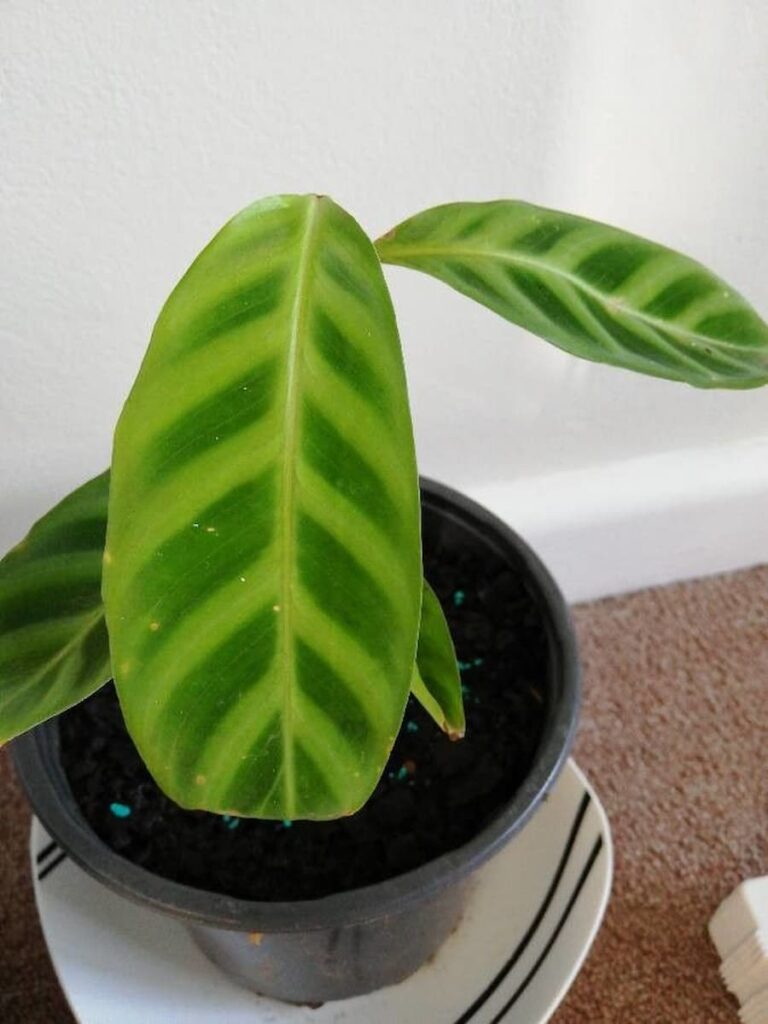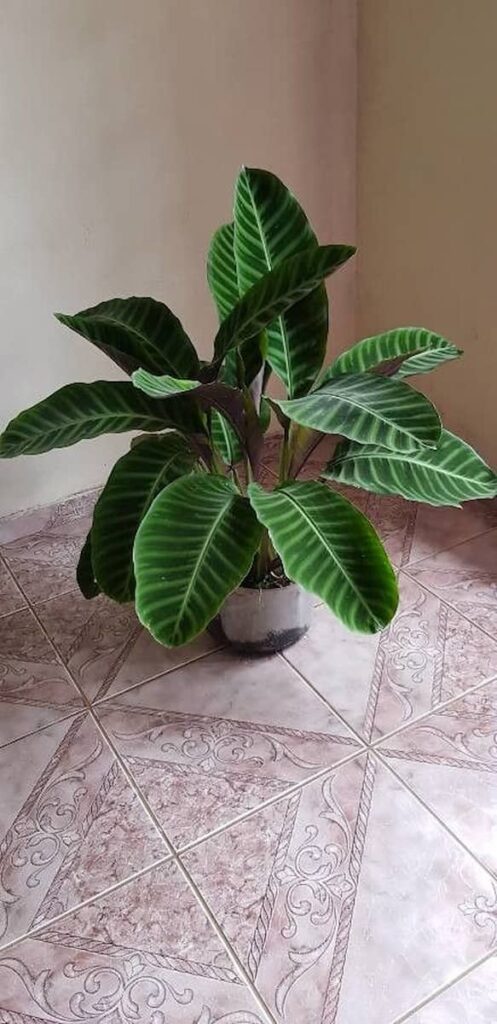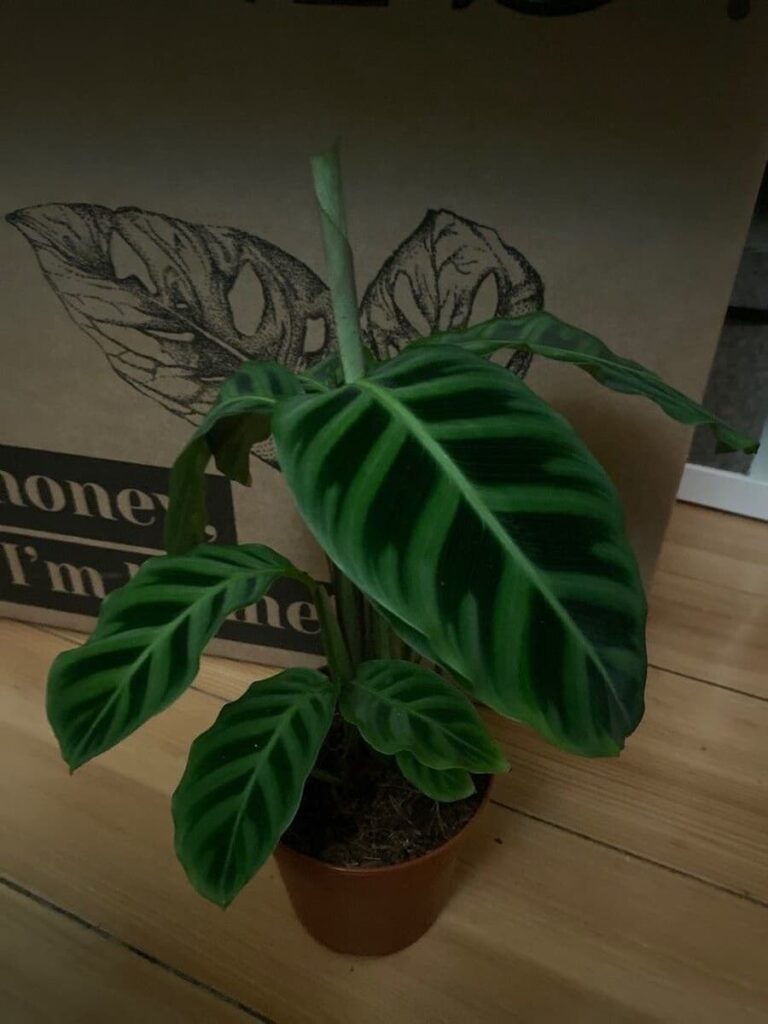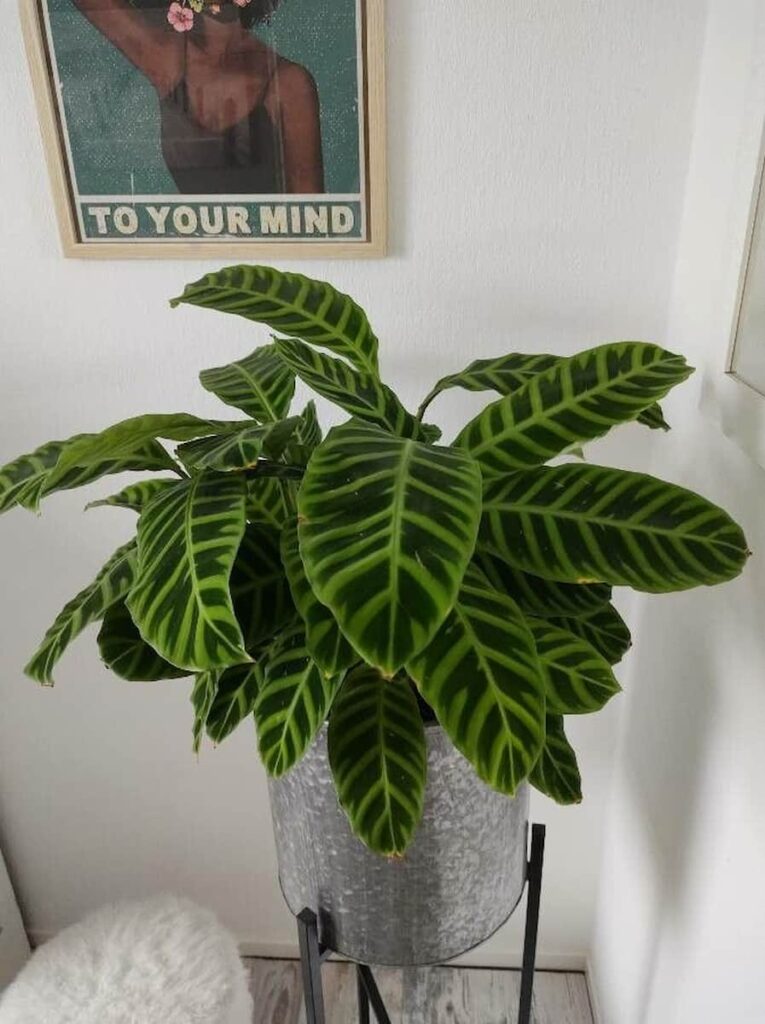Named for its zebra-patterned leaves, the Calathea zebrina is grown for its large, lush foliage that has a velvety texture and bright green zebra-striped pattern.
Each leaf has a purplish underside that isn’t usually noticeable because of the horizontal growth of this plant’s foliage – but when you do see it, it’s a pretty spectacular addition.
Gardeners who have experience growing Calatheas will have no problems caring for this tropical plant. Novice gardeners, however, should familiarize themselves with basic Calathea zebrina care to increase their chance of success growing this beautiful plant.

Table of Contents
How do you take care of a calathea zebrina?
One of the worst things you can do for your houseplants is to bring them into your indoor garden without first knowing the basic Calathea zebrina care requirements.
The truth is, not all plants need the same things, and trying to grow a plant when you have no idea what it needs to thrive is a quick way to kill that plant.
1. Plant in peat-based potting soil
The Calathea zebrina will grow the best when you plant it in a peat-based mixture. A good mixture for this plant is 1 part perlite and 2 parts peat. This rich mixture drains well, while still holding on to enough moisture to keep from drying out too quickly.
Avoid using soils that drain too quickly, such as cactus soils, or ones that are too compact. These types of soils are not suitable for Calatheas and will only leave the plant underwatered or overwatered.
Best soil for Calathea
Miracle-Gro Tropical Potting Mix
Light and well-draining (perfect for avoiding root rot) while being packed with just the right nutrients – that will feed your plant for up to six months. The best soil for keeping your calathea healthy and strong.
2. Bright, indirect sunlight
The best indoor location for the Calathea zebrina is close to a window facing east, west, or north. The light will need to be indirect as direct sun is too harsh for this plant and will damage its leaves.
A blind or sheer curtain will diffuse the direct light coming through the window and make it safe for the plant.

3. Water about once a week
Calatheas are moisture-loving plants that will typically need watered once a week during the spring and summer months. However, care must be taken not to overwater the plant since Calathea zebrina is susceptible to overwatering.
The best way to prevent this is to always check how dry the soil is before watering, and then only water it when the top inch of soil starts to feel dry.
When the Calthea zebrina goes into its dormant stage, which is in the fall and winter, expect to water the plant less. In fact, you may only have to water the calathea plant once or twice a month during this time period.

4. Keep temperatures warm
It’s no surprise that this tropical plant requires warm temperatures, especially when you consider that it is native to southeastern Brazil.
Keep the room where the Calathea zebrina will be living between 65 and 75 degrees Fahrenheit. Allowing the temps to fall below or above that range could throw the plant into shock.
Furthermore, keep the Calathea zebrina away from areas where the temperature can rise and fall drastically as this can cause the plant to go into shock.
Examples of areas not suitable for the Calathea zebrina include near a heating or cooling vent, drafty windows, or a main entrance.
5. Maintain a humidity level at 60-percent or more
Calatheas are humidity-loving plants, and the Calathea zebrina variety is no exception. This plant thrives at humidity levels at 60-percent or above, and subjecting it to levels below this can cause the plant to dry out.
To help prevent this from occurring, consider running a humidifier near the plant or set the plant on a drip tray.
Not giving the Calathea zebrina its ideal humidity level can quickly cause the plant to dry out. This is especially true if the temperature is higher than normal or conditions are just generally drier.

This is a common occurrence in the colder months when more artificial heat is used, which naturally pulls moisture from the air.
Misting the Calathea zebrina is a great way to keep the leaves clean and free of dust, while also introducing moisture into the air around the plant. By misting the plant, you’re providing it with some extra hydration, which is often needed when the environment is dry.
Just make sure you don’t overmist the plant to the point you increase the chance of fungal or bacterial issues.
6. Fertilize every two weeks during its active growing period
In the spring and summer, when the Calathea zebrina is actively growing, apply a balanced liquid fertilizer once every 2 weeks. Dilute the fertilizer to half its strength before applying and make sure to water the plant thoroughly before feeding.
Stop all feeding in the fall and winter when the plant has entered its dormant stage.
Best fertilizer for Calatheas
Jack’s Classic 20-20-20 All Purpose Fertilizer
A great fertilizer with the perfect balance for your calathea. Simply dissolve in water and feed your plant to watch it thrive.
Over-feeding is a concern, especially if you use too much fertilizer, the wrong type, or are trying to feed the Calathea zebrina with fertilizer that is out-of-date.
Seeing a white, salt-like substance on the surface of the soil is a good indicator that the Calathea zebrina has been over fertilized.
Over-fertilizing can cause the plant’s roots to burn, which is not a good thing if you want your Calathea zebrina to be healthy and happy. Thankfully, you can flush the excessive minerals out of the soil by holding the plant underneath running for several minutes.
Once the excess nutrients have been flushed out of the soil, avoid fertilizing the Calathea zebrina for a month or two.
Related: Best Calathea Fertilizer for Prayer Plants (+ When to Do It)
7. Repot the calathea zebrina once every year or every two years
Repotting the Calathea zebrina is done once a year or every two years as a way to refresh the soil.
You can also repot the plant if you notice roots growing out the bottom of the pot’s drainage holes, as this is a sign that the plant is becoming root bound and needs a bigger pot.
If repotting because the container is too small, select a new container that is no more than 3 times the size of the plant’s current root ball. Repotting the Calathea zebrina is a pot that is too big makes it harder for the plant to absorb nutrients.
With that said, however, planting the Calathea in a pot too small will cause the plant to become root bound quicker and require you to repot it much sooner than expected.

8. Propagate using the division method
Unlike some other houseplants, the Calathea zebrina cannot be propagated using stem or leaf cutting, and instead requires the division method.
Calathea zebrina produces “baby plants” around its base, and these younger plants can be cut off from its parent plant and then repotted in their own container.
This does, however, require removing the entire parent plant from its pot and then carefully separating the baby plants and its roots from the main plant and its roots.
Once the baby plant has been removed, simply plant it in a small container filled with the same soil as its parent plant and water thoroughly with distilled water.
Set the young Calathea in an area out of direct sun but where it can receive bright, diffused light. Keep the soil moist but not soggy, and make sure the temperatures are between 65 and 75 degrees with a humidity level of 60 to 90 percent.
Once new growth appears, you can cut back the watering to only when the soil starts to feel dry.
You may also be interested in: 10 Easy Steps to Propagate Calathea Plants
9. Avoid using tap water to water the calathea zebrina
Like other Calathea varieties, the Zebrina is sensitive to tap water due to the additional items that are usually found in this type of water.
Most municipalities add salts, minerals, chlorine, and fluoride to their water, which can quickly cause a build up in the plant’s soil. This buildup acts in a similar manner as too much fertilizer, burning the plant’s roots and leaves.

Using distilled water is the best option for the Calathea zebrina as it doesn’t contain these potentially damaging items.
Filtered water and rain water can also be used, but they too may have unwanted additives that can have a negative impact on the Calathea zebrina.
10. Keep the plant’s leaves hydrated when the environment is dry
Dry air makes it harder for the Calathea zebrina to stay hydrated, which means the plant becomes dehydrated, the soil dries out quicker, and the leaves become dry and brittle. Making sure the humidity level is at least 60-percent is the ideal option to prevent this from occurring. A humidifier is, of course, the easiest way to maintain moisture in the air even when conditions are dry.
You can also mist the plant’s leaves with distilled water during periods of dry conditions, or whenever you want to add some extra humidity to the air.
Just make sure that you are not over misting the plant and that the leaves dry out between each misting. Allowing water to sit on the leaves for an extended period of time can lead to fungal and bacterial issues, such as leaf spot disease.
11. Pruning isn’t required but can be used to clean up the calathea zebrina
As with any plant, the leaves on the Calathea zebrina will die as this is a natural occurrence and just part of the plant’s life. In most cases, these leaves will fall off the plant, but some may stay clinging to the Calathea, using up vital resources.
When this occurs, you can use a pair of sharp pruning shears to snip off the dead or dying leaf.

Removing the dead or dying leaves provides a couple of benefits for the plant. Not only does it improve the overall look of the Calathea zebrina, but it makes room for new, young growth to emerge.
It also stops the plant from wasting resources on a part that won’t get any better.
12. Watch out for overwatering
Overwatering is one of the biggest issues that can affect the Calathea zebrina. It is also one of the easiest problems to prevent. Calathea zebrina is susceptible to overwatering, which typically occurs when the garden doesn’t check to ensure the soil is dry before watering.
When the Calathea zebrina is overwatered, it opens the plant up to potential fungal and bacterial diseases, such as calathea root rot. As I’m sure you know, root rot is a serious disease that can quickly kill any plant it infects.

To make matters worse, trying to treat root rot is almost impossible and most plants succumb to the disease in a matter of weeks.
Thankfully, overwatering is easily prevented by simply inserting your finger into the top inch or two of soil to check to see how dry it is. If the soil is dry, go ahead and water the plant deeply.
If, however, the soil is still damp, wait a day or two and then check again.
13. Keep an eye on common houseplant pests
While common houseplant pests aren’t always an issue, they can and will feast on the Calathea zebrina if given the opportunity. Keeping a vigilant eye out for these pests will let you get the jump on them before they have a chance to severely infest the Calathea.
Regular examination of the plant, making sure to check the underside of the leaves, will quickly alert you to any signs of sap-sucking insects.
Use insecticidal soap or horticultural oil to treat the Calathea zebrina if you notice sap-sucking pests. These two pesticides are considered non-toxic and safe for use indoors around people and pets.
Apply the pesticides to the tops and undersides of the leaves, as well as the stems.
Always read and follow the instructions printed on the pesticide label. In most cases, you will need to reapply the pesticide once every 7 to 14 days.
However, the exact application directions may vary from one type of pesticide to the next.
Related: 9 Proven Steps to Treat a Calathea With Spider Mites
14. Keep new houseplants away from the calathea zebrina for 14 days
When new plants are brought in, too few gardeners actually quarantine them away from their other plants. In fact, a lot of gardeners are not even aware that quarantining new plants for 14 days is a good general rule of thumb to help protect your current plants from diseases and pests.
Even if you assume the new plant is not sick or infested, diseases and pests can hide themselves, just waiting to infect your Calathea zebrina.

Thankfully, you can keep all your plants safe by simply placing any new plants that you bring indoors in a room away from your other houseplants and keep it there for at least 14 days.
Regularly examine the new plant during its quarantine period, looking for any signs of issues. If, after the 14 days, no problems have appeared, you can transition the new plant to the same area as your Calathea zebrina.
15. Use the right type of pot for calathea zebrina
Whether you’re starting a new plant or simply repotting the Calathea in a new container, you should ensure that the pot is the right type for these tropical houseplants.
While Calathea zebrina can be successfully grown in containers made of various materials, you should always ensure that the pot has drainage holes at the very bottom. These holes allow the excess water to flow out of the pot freely.
Planting the Calathea in a pot without drainage holes or one that has drainage holes at the sides will increase the chance of overwatering the plant. Overwatering is one of the quickest ways to harm and even kill your Calathea zebrina.
Is calathea zebrina toxic?
The Calathea zebrina is a non-toxic houseplant, making it a wonderful choice for homes with children, dogs, and cats. Despite its non-toxic nature, you should still keep this plant away from little ones and pets. This isn’t because the plant can hurt them, but because they can hurt the Calathea.
While the Calathea zebrina is not necessarily a delicate plant, its foliage can become damaged if you allow children or animals to play with it. And damaged leaves can have a negative impact on the overall appearance of the plant.
Find out more about: Is Calathea Toxic to Cats, Dogs or Humans?
How fast does a calathea zebrina grow?
If given the right care, the Calathea zebrina can grow up to 2 feet every year. Despite this moderately fast growth rate, the Calathea zebrina doesn’t usually have a problem getting out of control.
This means this plant can be safely grown in compact areas since it usually only grows to under 40 inches tall.
How big does calathea zebrina get?
The Calathea zebrina can grow up to 40 inches tall. However, in most cases, this Calathea variety will reach heights of about 24 inches. Keep in mind, however, that how well you care for the plant will have a direct impact on how tall the Calathea zebrina gets.
No matter how well you care for your Calathea zebrina, however, the plant won’t get much taller than 40 inches. There is no way to force a plant to grow larger than its genetics will allow it.

Does calathea zebrina need pruning?
Calathea zebrina usually doesn’t require much pruning. In fact, pruning this plant is usually reserved only if you need to remove dead and dying leaves, which improves the overall appearance of the plant while also making room for new leaves.
In most cases, you won’t need to control the plant’s size, since it doesn’t usually get out of control. If you do need to reduce its size, healthy leaves can be safely removed as long as you do not prune off more than 1/4 of the plant’s foliage.
Additionally, pruning should be done in spring or early summer when the plant is actively growing.
Does calathea zebrina flower?
Calathea zebrina rarely blooms when grown indoors as a houseplant. That doesn’t mean it cannot bloom, but the chances of your indoor Calathea blooming are slim to none. The flowers it does produce are small, white or purplish in color, and form at the tip of upright stalks.
When in the wild, the Calathea zebrina does bloom often. But even then, the flowers it produces are not nearly as showy as its impressive foliage.
So, don’t fret if your Calathea zebrina doesn’t bloom, as it’s not a common occurrence when the plant is grown inside.

Why is my calathea not happy?
An unhealthy Calathea is directly related to the care it is receiving, or not receiving. If you want to make your Calathea zebrina happy, try to give the plant its ideal growing conditions. This means bright, indirect light, peat-based potting mix, warm temperatures, regular watering, high levels of humidity, and fertilizer.
Where should I place my calathea?
The best place to put your Calathea zebrina is in a sunny room where it will receive bright, indirect light for at least 8 to 10 hours a day. Avoid any areas where the light shines directly on the plant. Use curtains or blinds to diffuse any harsh lighting shining in through the windows.
Additionally, the room where the plant will be living needs to have a temperature of no less than 60 degrees and no more than 80 degrees. Avoid rooms where the temperature fluctuates drastically.
Why are my calathea zebrina’s leaves curling?
Leaf curling is often a sign that your Calathea zebrina isn’t getting enough moisture. When this occurs, the leaves can become dry, brittle, and curled. If the issue is corrected, the plant will begin to wilt, the stems will become weak, and the plant’s growth can suffer.
This can also occur when the air is too dry or the temperature is too hot. The good news is that these issues are fairly easy to correct. Simply water the Calathea zebrina deeply and add moisture into the air by using a humidifier, drip tray, or misting its leaves.
Related: 6 Causes of Your Calathea Leaves Curling (+ How to Fix It)
Why do my calathea zebrina’s leaves have brown edges?
The brown edges on the leaves of your Calathea zebrina are typically caused by tap water. Tap water contains a slew of additives, such as salts, fluoride, minerals, and chlorine, that can accumulate in the soil of houseplants. These additives can lead to chemical burns, which cause the leaves to brown.
Not all plants are sensitive to tap water, but Calatheas are one of them that can quickly become damaged by hydrating the plant with the wrong water. Using distilled water will help prevent this from occurring.


